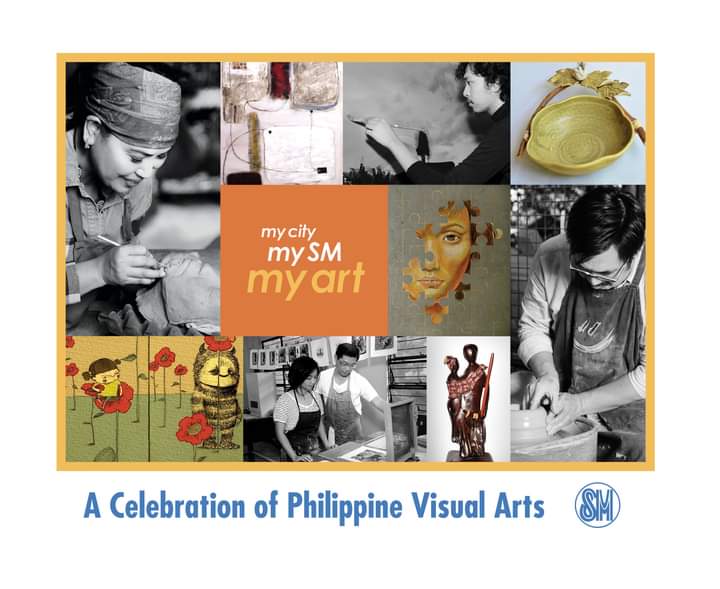My City, My SM, My Art, which recently launched its book just in time for theNational Arts Month,is the latest edition in the My City, My SM series, which celebrates the beauty, culture, traditions, and great people in cities around the Philippines where SM has malls.
This comes after My City, My SM, which promotes tourism; My City, My SM,My Cuisine, which highlights heirloom recipes from prominent families in the different regions; and My City, My SM, My Crafts, which showcases traditional arts and modern Philippine design.
My City, My SM, My Artcelebrates Philippine visual arts – painting, sculpture, printmaking, photography, and filmmaking. It aims to bring people and art together in a roadshow featuringthe works of masters, modernists, and millennialsaround the SM Supermalls.
The cultural journey began on March 2016 at SM Seaside City in Cebu with an exhibit featuring artists from the Queen City of the South including maestro Romulo Galicano; and concluded on March 2019 at SM City Cebu with the masterpieces of Manuel Rodriguez, Sr., the Father of Philippine Printmaking leading the way.

In between, their search for art and artists brought them as far north as the Baguio and the Cordilleras and as far south as General Santos in Mindanao. During those three years, they advocated art for all by working closely with communities, schools, and the public to mount exhibits, workshops, and contests in key cities around the Philippines. These were featured in the Philippine Star, as project partner, as well as in local media, and a cultural series in regional cable channels.
To make all these possible, SM collaborated with the National Commission for Culture and the Arts, the Metropolitan Museum of Manila, and the Shell Companies of the Philippines; as well as the Philippine Star, Center Stage Productions, and Finale Art File.
Along the way, they were able to have a glimpse of what makes Philippine art unique, and how close family ties, ingenuity, and a sense of communityhave played key roles in its development.
Filipino art has flourished through families like the Abellanas of Cebu; as well as those of masters Mauro Malang Santos, Jose Pitok Blanco, and Eduardo Castrillo whose children – and in some cases grandchildren –now represent a new generation visual artists. There are also wonderful examples of how art ties fathers and sons together – National Artist Abdulmari Imao and Toym, National Living Treasure Eduardo Mutucand Eduardo, Jr., RicartePurugananand Victor, Manuel Baldemor and Monnar, Romulo Olazo and Jonathan.

Family members have also played significant roles in preserving the artistic legaciesof their loved ones: Josie Baldovino for her brother National Artist Jose Joya, Daisy Tolentino-Mendez for her father National Artist Guillermo Tolentino, andTotong Francisco II for his grandfather National Artist Carlos Botong Francisco. We wereboth honored and touched when the family of Manuel Rodriguez, Sr. flew all the way from the US and the Bahamas to join us in the tribute to their father at SM City Cebu.
They were also amazed at how Filipino artists created groundbreaking works from non-traditional materials. With art supplies either too costly or simply unavailable, Baguio’s Jordan Mang-osan and PatricPalasi found their niche in solar and coffee art, respectively; while Palawan’s ElordieMesaccrafted his pieces from rubber slippers. When his materials were washed away by super-typhoon Yolanda, Tacloban-born Dante Enage began using tuba, a local wine made from coconut juice, as his medium.
The rise of regional Fine Arts schools like the Philippine High School for the Arts in Laguna, the University of Mindanao, the University of Rizal System, La Consolacion College in Bacolod, Ateneo de Naga, and the Adventist University of the Philippines in Cavite have likewise been vital to the growth of the arts around the country.
They also saw how art thrived when artists got together in collectives like the Tam-Awan Village in Baguio, the Artist’s Village in Baler, and Pinto Art Museum in Rizal.
Now, after three years, more than 30 stops, hundreds of artworks, and a myriad of memorable experiences, they have compiled our exciting cultural journey in a book. Join as we unravel the exquisite tapestry of Philippine art through the lives andworks of some of the country’s most fascinating visual artists.
Join in the cultural adventure at microsite https://mystorymysm.com/mycitymysmmyart/ and YouTube Channel at https://www.youtube.com/mycitymysmmyart. Please also watch out for the television series over When In Rizal and When In Rizal PH on Facebook.




